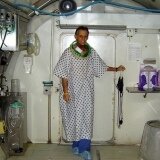Compartment Syndrome And
Hyperbaric Oxygen Therapy (HBOT)

Compartment Syndrome (CS) occurs when an increasing internal pressure within a confined spaces in the body (or compartments)) damaging their regular neurovascular functions.
CS usually develops as a complication of the trauma if the compartment pressure exceeds the capillary perfusion pressure.
Usually CS affects sites of the body called fascial compartments found around muscles.
Fascial compartment tissues form a membrane layers around our muscles and can be found in limbs, legs, foots, forearms, arms, and buttocks. However, any closed anatomic space, including the abdominal cavity, is at risk of developing a compartment syndrome.
CS frequently occurs in extremities when body tissues are severely traumatized by accidents such as motor vehicle accidents, falls, gunshot wounds, crush injuries, earthquakes, snake bites, internal bleeding from an injured blood vessels, burns, etc.. One of the most common causes of the CS is a fractured bone (broken bone). In some rare cases IV infusions, e.g. drugs given via vein and leaking internally inside the tissue around the vein can also cause CS. Untreated CS can affect the muscles blood supply resulting in necrosis (death) of the muscles.
When used as an adjunct to a surgery and antibiotics, Hyperbaric Oxygen Therapy shows promise as a way to decrease complications from severe instances of acute compartment syndrome. HBOT increases oxygen delivery to the injured tissues, reduces swelling and provides an improved environment for healing and fighting infection.
Hyperbaric oxygen treatment should be started as soon after an injury as possible. HBOT treatments should usually continued for 5 to 6 days. A number of related conditions, including crush injuries, thermal burns, and threatened replantations are also benefited by Hyperbaric Oxygen, as discussed in other sections of this site.
Abdominal Compartment Syndrome (ACS)
An elevated intra-abdominal pressure (IAP) due to tissue edema or free fluid accumulation in the abdominal cavity may cause the Abdominal Compartment Syndrome (ACS). The undetected or untreated intra-abdominal hypertension and consequent ACS is multisystem organ failure which may be fatal.
A fluid accumulated in the abdominal wall and fascia can slowly expand stretching the fascia and the abdominal wall to the point when they become incompliant because of the pressure within the abdominal cavity. Interstitial edema in the bowel and mesentery due to capillary endothelial damage may lead to IAP and ACS resulting in many liters of interstitial fluid accumulated within intra-abdominal compartment.
Early detection of elevated abdominal pressure is crucial because it allows urgent intervention thus preventing ACS from developing and therefore promoting a much better prognosis for the patient.
When the intra-abdominal pressure elevates above 8-10 mm Hg the risk of developing ACS is high. The intra-abdominal pressure elevated beyond 20 mm Hg leads to an irreversible tissue damage, ultimately resulting in ACS and multiple organ failure. Surgical decompression remains a standard for rapid, definitive treatment of fully developed abdominal compartment syndrome, but nonsurgical measures can often effectively affect lesser degrees of intra-abdominal hypertension and abdominal compartment syndrome.
The examples of clinical conditions associated with development of ACS include surgical operations, trauma, sepsis, ischemia reperfusion, SIRS (systemic inflammatory response syndromes), capillary leak, visceral compression, critical obstetrical conditions.
Anterior Compartment Syndrome
The anterior (front) compartment is one of the four compartments present in our legs or calves. The other three are: the lateral (outside) compartment, the deep posterior (back) compartment and the superficial posterior compartment. Each compartment is separated by a tissue called fascia which is forming a membrane layers around our muscles.
Anterior Compartment Syndrome may be acute or chronic. Acute anterior compartment syndrome is caused by trauma, fracture, or other injuries causing swelling and bleeding into the compartment which increases the internal pressure.
Chronic Compartment Syndrome, also called exercise induced compartment syndrome or exertional compartment syndrome is usually experienced by long distance runners, and other athletes. The condition is caused by strenuous, repetitive activity such as over exercising. In such cases a muscle may swell due to the increased blood flow to the area in order to supply the muscle. Sometimes the outcome is an increased pressure on the veins, increased pain and possible muscle damage.
Among the symptoms of anterior compartment syndrome are altered sensations, gradual onset of pain, weak or absent pedal pulses, muscle weakness, a cool limb. The pain is often described as a feeling of tightness, a burning pain. Sometimes the pain is a vague, deep, the kind of pain that is difficult to localize. If nerve is involved, there may be a numbness (loss of sensation) on the top of the 1st, 2nd and 3rd toe. If blood supply is compromised pedal pulses may be lessened or absent.
If symptoms persist for more than 2-3 months, surgery should be considered to relieve the pressure in the affected compartment. There is a high success rate following surgery for anterior compartment syndrome - 90% with slightly higher success in women.
In acute crush injury and/or CS Hyperbaric Oxygen Therapy (HBOT) is beneficial during the impending stage, when objective signs are present, e.g. pain, tense compartment, weaknes, etc.. After the patient has undergone fasciotomy, HBOT can be beneficial in helping to decrease morbidity.121
HBOT should be started as soon as feasible. After a surgical procedures, Hyperbaric Oxygen Therapy should be considered for 60-90 minutes at 2-2.5 ATA. For the next 3 days HBOT treatment should be repeated 3 times a day, then for the next 3 days twice a day, and then once a day for the 2-3 days.120













